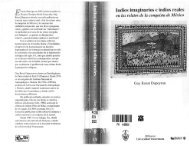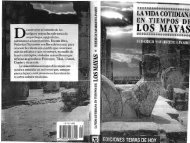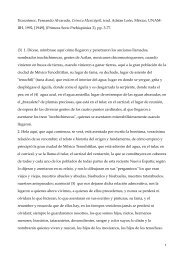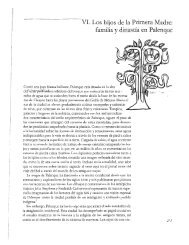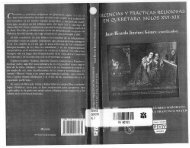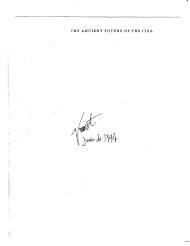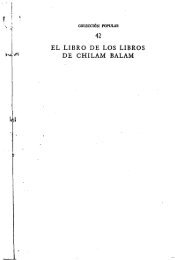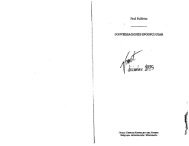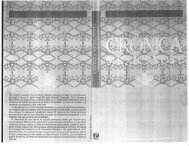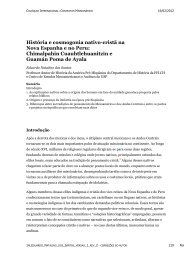HEAVEN BORN MERIDA AND ITS DESTINY - Histomesoamericana
HEAVEN BORN MERIDA AND ITS DESTINY - Histomesoamericana
HEAVEN BORN MERIDA AND ITS DESTINY - Histomesoamericana
Create successful ePaper yourself
Turn your PDF publications into a flip-book with our unique Google optimized e-Paper software.
id Izamal<br />
/ed again in<br />
iu hegemony<br />
in the east,<br />
pan in the<br />
i cycle apkatun<br />
in<br />
the Books<br />
Jaguars, and<br />
the seating<br />
n Cab A and<br />
)e for an<br />
due 'the<br />
1448 they<br />
:ed a new<br />
a and near<br />
which hit<br />
as appar-<br />
Ceel. The<br />
Tzim Thul,<br />
ie primary<br />
was hatched<br />
Df other<br />
Kak Mo,<br />
s also related<br />
tion of the<br />
be named at<br />
) the act by<br />
s Spokesthe<br />
cycle as<br />
, thus giving<br />
amal.<br />
i, Hapay<br />
an at Chilip<br />
of that<br />
îre deter-<br />
: Ceel de-<br />
!ch, naming<br />
enote at<br />
f the events<br />
t was made<br />
t Xib Chac,<br />
ichen was<br />
ly West<br />
INTRODUCTION 39<br />
priest as well (the "father of the rain priests"). Apparently at the instigation<br />
of Hunac Ceel and Can Ul, the delegation was seized at Izamal and<br />
sacrificed. This appears to have been more or less simultaneous with the<br />
seizure of the walls of Mayapan and the expulsion of the Itza from there.<br />
The Chumayel lists the Ba Cabs of Mayapan as Co Uoh, Ah Ek, Zulim<br />
Chan, and Nahuat (reading from east to south). Presumably they were<br />
all Xiu.<br />
The decision on the Izamal succession then went to Hapay Can, apparently<br />
a compromise candidate, but there was a considerable amount of<br />
confusion and local opposition. Finally, in 1458, Hapay Can was deposed<br />
by Can Ul, whose claim to the lordship of Izamal was almost certainly<br />
based on an incestuous union (see the Tizimin) but who was an ally of<br />
Hunac Ceel. Hapay Can was sent to Chem Chan, a village dependent on<br />
Uxmal, where he was sacrificed. Kukul Can became governor of Chichen<br />
Itza, Can Ul became governor of Izamal, and apparently both claimed the<br />
Jaguar priesthood. Cau Ich continued as governor of Mayapan, Uxmal<br />
Chac (another name for Hunac Ceel?) of Uxmal, Kak Mo of Champoton,<br />
and Tzim Thul of Merida, and apparently all of them claimed to seat the<br />
katun.<br />
The fall of Mayapan definitively ended the religious and political unity<br />
of Yucatan. Subsequent prophets from the fifteenth to the nineteenth and<br />
twentieth centuries pled for unity, but the basis for it—agreement on the<br />
calendar—had been destroyed. Underlying personalities and the calculation<br />
of personal advantage was the argument between the Xiu and the Itza<br />
about the dating of the may. Mayapan fell on Xiu time (8 Ahau rather<br />
than 13 Ahau), and the Itza could neither forgive nor forget that fact. The<br />
interlude between the two dates, 1461 and 1539, was marked by increasing<br />
turmoil and disunion.<br />
The victors of the conspiracy of Mayapan (Can Ul, Hunac Ceel, Cau<br />
Ich, and Kak Mo) were not victorious for long: they all disappeared from<br />
history in the following katun. Hunac Ceel claimed the right to seat 6<br />
Ahau at Uxmal, but the katun was also claimed by Hunac Thi and Teabo<br />
and just about everybody else. Champoton was put out of business by<br />
Izamal. The Chumayel notes that the last (major?) pyramid was built in<br />
1467. It does not say where.<br />
The nobles were having plenty of trouble with each other. There were<br />
no less than seven claimants to the seating of 4 Ahau. But by that time<br />
they were having trouble with the peasants as well. A resurgent Kukul<br />
Can seated the katun at Chichen Itza and attacked the Xiu. There were<br />
plagues. And the peasantry took to the woods and formed guerrilla bands<br />
to defend themselves from the tribute and captive raids of the marauding<br />
nobles. Modeled after the military orders of the nobility, these companies<br />
were a prominent feature of the disturbances of the sixteenth and early<br />
seventeenth centuries. They are first mentioned in the prophecy of Ahau<br />
Pech in 4 Ahau: Ants, Many Skunks, Hanging Rabbits, Cowbirds, Magpies,<br />
Blackbirds, and Mice.<br />
As sun priest and Spokesman, apparently at Teabo, Ahau Pech predicted<br />
the demise of these orders in 4 Ahau, but he must have got his glyphs



